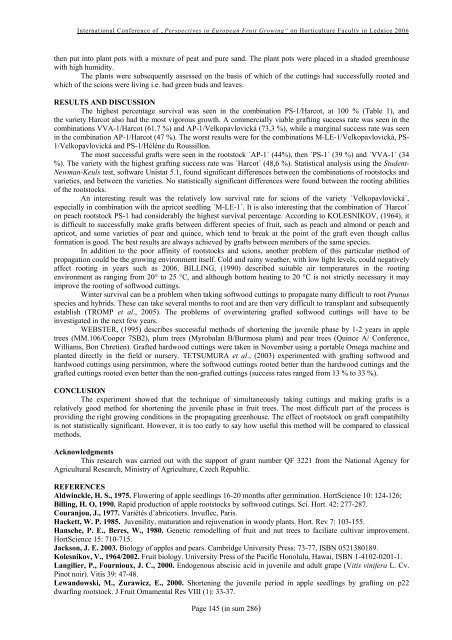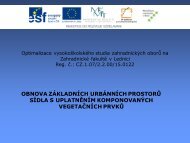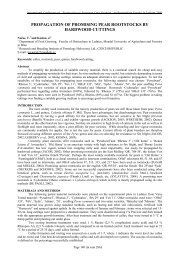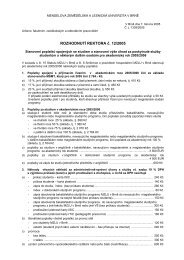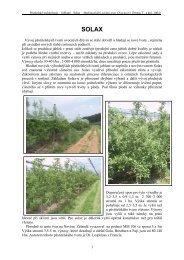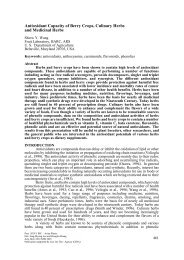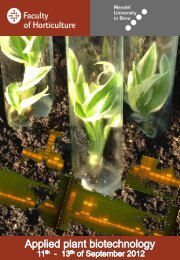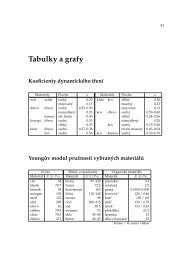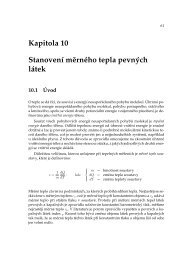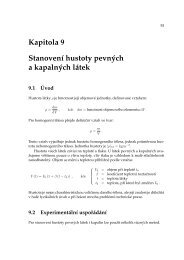simultaneously grafted softwood cuttings of rootstocks for apricots
simultaneously grafted softwood cuttings of rootstocks for apricots
simultaneously grafted softwood cuttings of rootstocks for apricots
Create successful ePaper yourself
Turn your PDF publications into a flip-book with our unique Google optimized e-Paper software.
International Conference <strong>of</strong> „Perspectives in European Fruit Growing“ on Horticulture Faculty in Lednice 2006then put into plant pots with a mixture <strong>of</strong> peat and pure sand. The plant pots were placed in a shaded greenhousewith high humidity.The plants were subsequently assessed on the basis <strong>of</strong> which <strong>of</strong> the <strong>cuttings</strong> had successfully rooted andwhich <strong>of</strong> the scions were living i.e. had green buds and leaves.RESULTS AND DISCUSSIONThe highest percentage survival was seen in the combination PS-1/Harcot, at 100 % (Table 1), andthe variety Harcot also had the most vigorous growth. A commercially viable grafting success rate was seen in thecombinations VVA-1/Harcot (61.7 %) and AP-1/Velkopavlovická (73,3 %), while a marginal success rate was seenin the combination AP-1/Harcot (47 %). The worst results were <strong>for</strong> the combinations M-LE-1/Velkopavlovická, PS-1/Velkopavlovická and PS-1/Héléne du Roussillon.The most successful grafts were seen in the rootstock ´AP-1´ (44%), then ´PS-1´ (39 %) and ´VVA-1´ (34%). The variety with the highest grafting success rate was ´Harcot´ (48,6 %). Statistical analysis using the Student-Newman-Keuls test, s<strong>of</strong>tware Unistat 5.1, found significant differences between the combinations <strong>of</strong> <strong>rootstocks</strong> andvarieties, and between the varieties. No statistically significant differences were found between the rooting abilities<strong>of</strong> the <strong>rootstocks</strong>.An interesting result was the relatively low survival rate <strong>for</strong> scions <strong>of</strong> the variety ´Velkopavlovická´,especially in combination with the apricot seedling ´M-LE-1´. It is also interesting that the combination <strong>of</strong> ´Harcot´on peach rootstock PS-1 had considerably the highest survival percentage. According to KOLESNIKOV, (1964), itis difficult to successfully make grafts between different species <strong>of</strong> fruit, such as peach and almond or peach andapricot, and some varieties <strong>of</strong> pear and quince, which tend to break at the point <strong>of</strong> the graft even though callus<strong>for</strong>mation is good. The best results are always achieved by grafts between members <strong>of</strong> the same species.In addition to the poor affinity <strong>of</strong> <strong>rootstocks</strong> and scions, another problem <strong>of</strong> this particular method <strong>of</strong>propagation could be the growing environment itself. Cold and rainy weather, with low light levels, could negativelyaffect rooting in years such as 2006. BILLING, (1990) described suitable air temperatures in the rootingenvironment as ranging from 20° to 25 °C, and although bottom heating to 20 °C is not strictly necessary it mayimprove the rooting <strong>of</strong> <strong>s<strong>of</strong>twood</strong> <strong>cuttings</strong>.Winter survival can be a problem when taking <strong>s<strong>of</strong>twood</strong> <strong>cuttings</strong> to propagate many difficult to root Prunusspecies and hybrids. These can take several months to root and are then very difficult to transplant and subsequentlyestablish (TROMP et al., 2005). The problems <strong>of</strong> overwintering <strong>grafted</strong> <strong>s<strong>of</strong>twood</strong> <strong>cuttings</strong> will have to beinvestigated in the next few years.WEBSTER, (1995) describes successful methods <strong>of</strong> shortening the juvenile phase by 1-2 years in appletrees (MM.106/Cooper 7SB2), plum trees (Myrobalan B/Burmosa plum) and pear trees (Quince A/ Conference,Williams, Bon Chretien). Grafted hardwood <strong>cuttings</strong> were taken in November using a portable Omega machine andplanted directly in the field or nursery. TETSUMURA et al., (2003) experimented with grafting <strong>s<strong>of</strong>twood</strong> andhardwood <strong>cuttings</strong> using persimmon, where the <strong>s<strong>of</strong>twood</strong> <strong>cuttings</strong> rooted better than the hardwood <strong>cuttings</strong> and the<strong>grafted</strong> <strong>cuttings</strong> rooted even better than the non-<strong>grafted</strong> <strong>cuttings</strong> (success rates ranged from 13 % to 33 %).CONCLUSIONThe experiment showed that the technique <strong>of</strong> <strong>simultaneously</strong> taking <strong>cuttings</strong> and making grafts is arelatively good method <strong>for</strong> shortening the juvenile phase in fruit trees. The most difficult part <strong>of</strong> the process isproviding the right growing conditions in the propagating greenhouse. The effect <strong>of</strong> rootstock on graft compatibiltyis not statistically significant. However, it is too early to say how useful this method will be compared to classicalmethods.AcknowledgmentsThis research was carried out with the support <strong>of</strong> grant number QF 3221 from the National Agency <strong>for</strong>Agricultural Research, Ministry <strong>of</strong> Agriculture, Czech Republic.REFERENCESAldwinckle, H. S., 1975. Flowering <strong>of</strong> apple seedlings 16-20 months after germination. HortScience 10: 124-126;Billing, H. O, 1990. Rapid production <strong>of</strong> apple <strong>rootstocks</strong> by <strong>s<strong>of</strong>twood</strong> cutings. Sci. Hort. 42: 277-287.Couranjou, J., 1977. Variétés d’abricotiers. Invuflec, Paris.Hackett, W. P. 1985. Juvenility, maturation and rejuvenation in woody plants. Hort. Rev 7: 103-155.Hansche, P. E., Beres, W., 1980. Genetic remodelling <strong>of</strong> fruit and nut trees to faciliate cultivar improvement.HortScience 15: 710-715.Jackson, J. E. 2003. Biology <strong>of</strong> apples and pears. Cambridge University Press: 73-77, ISBN 0521380189.Kolesnikov, V., 1964/2002. Fruit biology. University Press <strong>of</strong> the Pacific Honolulu, Hawai, ISBN 1-4102-0201-1.Langilier, P., Fournioux, J. C., 2000. Endogenous abscisic acid in juvenile and adult grape (Vitis vinifera L. Cv.Pinot noir). Vitis 39: 47-48.Lewandowski, M., Zurawicz, E., 2000. Shortening the juvenile period in apple seedlings by grafting on p22dwarfing rootstock. J Fruit Ornamental Res VIII (1): 33-37.Page 145 (in sum 286)


